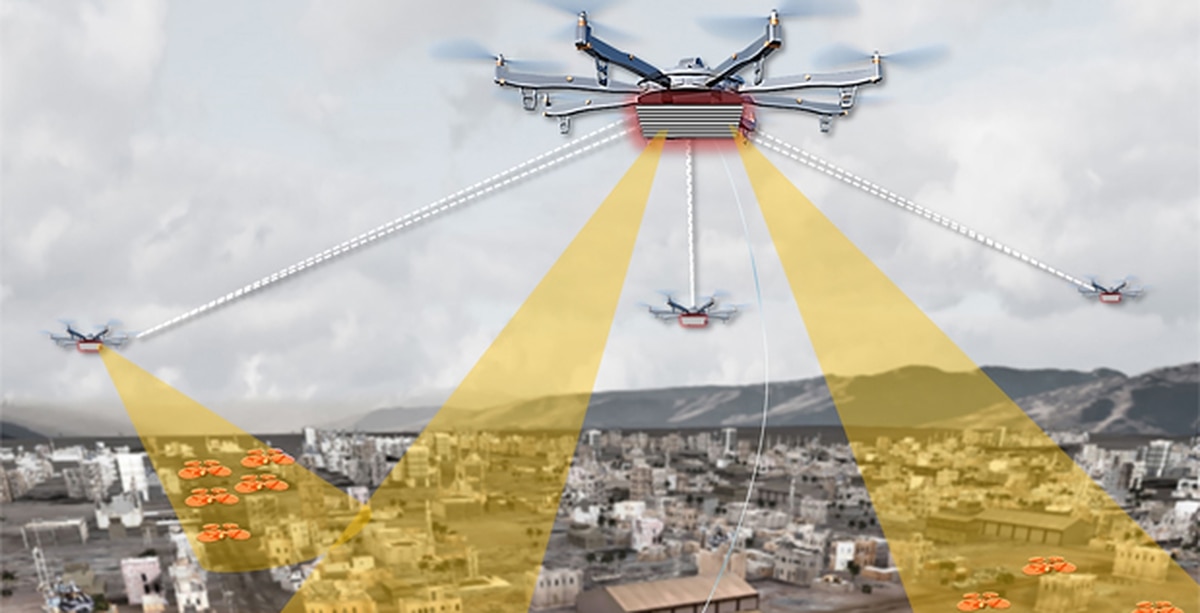The Defense Advanced Research Projects Agency (DARPA) is developing the Aerial Dragnet.
It is a system that provides a wide-area surveillance capability that uses sensors mounted on drones to detect, classify and track small drones in dense urban environments.
DARPA’s Aerial Dragnet program aims to achieve the technically difficult goal of detecting and tracking small UAS in urban terrain. The program seeks innovative technologies to provide persistent, wide-area surveillance of all UAS operating below 1,000 feet in a large city. While Aerial Dragnet’s focus is on protecting military troops operating in urban settings overseas, the system could ultimately find civilian application to help protect U.S. metropolitan areas from UAS-enabled terrorist threats.
“We’re using drones to find drones, essentially,” Paul Zablocky, a program manager with the DARPA Strategic Technology Office said, during a C4ISRNET Conference on April 21st.
The government is concerned about the various dangers posed by small UAS (Unmanned Aerial Systems), which can be armed with explosives or used to collect sensitive information.
“A small drone certainly poses a threat, and we’ve seen that at airports. We’ve seen on the news where they’ve been equipped with explosives. We’ve seen them used for ISR [intelligence, surveillance and reconnaissance] capabilities. And these can be used against our soldiers as well as civilian populations, so there’s certainly a threat there, and they are widely available,” explained Zablocky.
DARPA wants Aerial Dragnet to eventually be able to interface with C-sUAS (Counter Small Unmanned Aerial Systems), passing along its tracking data from optical sensors, acoustic sensors and inexpensive radars so that the weapon system can defeat the threat.
Aerial Dragnet was tested in San Diego in 2019 and more recently in Rosslyn, Virginia.
The San Diego event was the first test of the system in a dense urban environment, and Zablocky said he was surprised how much clutter showed up in the data. Using data from that test, DARPA has been able to refine its signal processing algorithms, he said.
Essentially, DARPA is done testing the system, and it is looking into transitioning the program to another organization for further testing and development.
“We’re in conversations now with transitioning that program over. There’s still a lot of research and development to do,” said Zablocky. “So we’ve brought down a lot of the risks. We’ve — as I said — collected a lot of data and have a much better understanding of what needs to be done, but to really turn this into a capability or product will still take some work, so we are in conversations with various organizations to pick it up and continue to run with it.”
As per the tender that’s currently posted by DARPA, the system’s capabilities and specifications are set out.
“DARPA is soliciting innovative research proposals for persistent, wide-area surveillance of small unmanned aerial systems (UASs) in urban terrain on a city-wide scale. Proposals are solicited for a scalable network of sensors on aerial platforms performing threat-agnostic UAS detection, classification, and tracking by looking over and into complex terrain.
Aerial Dragnet seeks to perform persistent wide-area surveillance of multiple small unmanned aerial systems (UASs) in urban terrain on a city-wide scale. Small UASs are rapidly becoming low-cost aerial platforms for hostile reconnaissance, targeting, and weapon delivery.”
This is important, since the US expects to fight more in an urban environment in the future.
“In future urban battlegrounds, U.S. forces will be placed at risk by small UAS which use buildings and naturally-occurring motion of the clutter to make surveillance impractical using current approaches. The rapid proliferation of commercial UAS with increasing endurance and payload capacity drives the need for a future urban aerial surveillance system that can detect, track, and classify many different UAS types at longer ranges in urban terrain.”
MORE ON THE TOPIC:







They are preparing for the civil war, it is becoming inevitable, and at the same time they abandon the claims to fight wars against artists of equal or greater power, such as Russia and China, now the Yankee no longer have money and not even the industrial and military capabilities for that, Yankeestan is leaving the stage.
IF You live on Mars, You can contact the new lander there. They see more then You. But be aware it has pest control and soap too.
So far it seemes to be too much Monty Pyton, but we will see. Many things are pilot projekt these days.
We ever see the Armata.
The US fantasising about weapons they can’t build.
Nothing new here to report, just another in a long line of dreams and wishes of fantasists with a budget to waste.
It is only taxpayers money after all.
“It is a system that provides a wide-area surveillance capability that uses sensors mounted on drones to detect, classify and track small drones in dense urban environments.”
Just perfect for NY, LA, SF, Chgo.
Wow, right out of the movies.
Nothing to fear the Marvel Comic heroes are on their way.